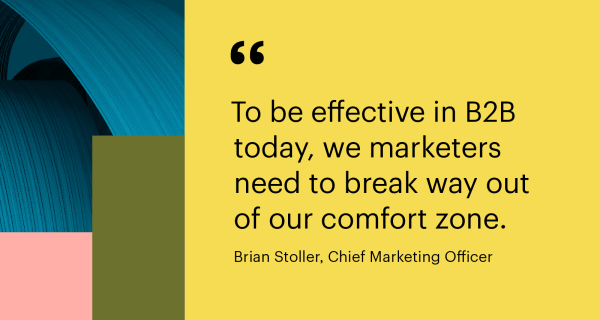The tech purchase process is becoming harder on buyers and sellers alike. As buying teams grow and vendor landscapes become more crowded, buyers now face an overwhelming array of options, straining them when it comes time to evaluating which solutions best meet their needs. At the same time, tech marketers struggle to establish thought leadership and engage the full buying team effectively enough to stand out in a highly competitive market.
But there’s a bright spot—data shows us that buyers’ pain points throughout the purchase process can be alleviated by holistic brand to demand strategies that connect the full buying team, all while building awareness that fosters trust.

Get in front of the pack early with high-quality, relevant content
One of ITDMs’ greatest challenges lies in wading through the abundance of vendor content to find truly helpful information. In Foundry’s latest Customer Engagement Study, 87% of ITDM respondents agreed that finding high-quality content online was a challenge, and when they did download content, less than half of it proved useful or actionable. Among their top complaints, they said most content today contained too much marketing hype or empty buzzwords, was biased, and too generalized to be useful.
Especially in the early stages of the purchase journey, when buyers are determining their technical needs and requirements, marketers need to focus on engaging key stakeholders with useful, actionable, and specialized content. A solid content strategy focused on your ICP is essential here. Whether you’re aiming to solve an existing problem of theirs or offering an entirely new innovation, set your brand apart by establishing and differentiating it as a beacon of guidance amongst a sea of sameness.
Educate buyers through the hardest stage of the buyer journey—vendor evaluation
As marketers move onto nurturing, buyers are entering the evaluation stage of their journey. It should be noted that the evaluation stage is the most arduous part of the enterprise purchase process for ITDMs, due to a lack of time, resources, and skilled staff required to properly evaluate the vast vendor landscape. Our latest Role & Influence Study found that the evaluation stage was the top area where ITDMs both said the purchase process was likely to stall (37% agreed) and where they admitted they could use some assistance from vendors (46% agreed). ITDMs also say that this is the stage where they want to meet with vendors in person, to better understand how unique vendor features apply to their unique use cases.
To help get them through this stage, ITDMs will appreciate content and conversations that help them develop clarity on their needs and are educational for both them and their non-technical counterparts. In fact, 72% say that if a vendor can educate them throughout the entire journey, chances are they will make the shortlist.
Bonus points if you can present educational content in a structured fashion—74% of ITDMs say they prefer content delivered as a thoughtfully organized experience. Treat this stage of the journey like a lesson plan designed to empower buyers with the knowledge they need to act confidently.
Remember—you need the full buying team on your side
Engaging, nurturing, and converting your end-users is just half the battle. B2B buying teams today are made up of a whopping 28 people, and while some of them have spent the last few months immersed in your content, some will still need educating and convincing.
At this stage, ITDMs will be advocating for their chosen vendor to a larger group of stakeholders who may not need to understand the technical requirements but will bring their own priorities to the table (financial, legal, etc.).
The internal sell-through process is not just a critical stage of the purchase journey—it’s where brand efforts pay off. 78% of ITDMs say that brand trust helps immensely here, and 68% say that the internal sell-through process is easier if all stakeholders are aware of the brand in question. Throughout the sales cycle, as marketers work to strategically deliver educational content to key decision-makers, they must also use brand tactics such as social, advertising, and events to cast a wider net around the full buying team. Come decision time, being the known brand can tend to tip the scales.
It takes a village
There’s no doubt that tech marketers’ jobs are becoming more difficult as tech buying complexity continues to grow. Success today requires a comprehensive approach that combines brand and demand, builds familiarity and delivers educationally, and can surround many while personalizing for a few. It also requires access to an engaged and diverse audience throughout the full buying journey.
Above all, successful tech marketing requires support. By working with partners who understand IT buyers’ preferences and challenges throughout the purchasing process, marketers can hone their full-funnel efforts to better align to buyer needs at specific stages. As we look to 2025 and beyond, the marketers equipped with the right buyer insights, access, and trust will be the ones who differentiate and succeed.






